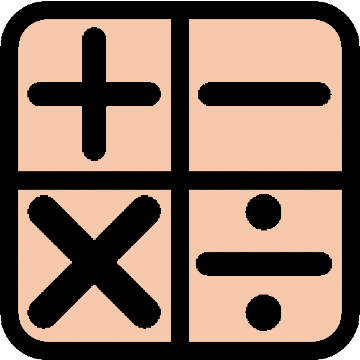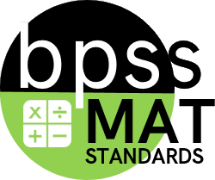MAT-09.NO.02

|
9th Grade (MAT) Targeted Standard
(NO) Number and Operations
Learners will develop a foundational understanding of the number system, operations, and computational fluency to create connections and solve problems within and across concepts.
|
MAT-09.NO.02 Perform basic operations on simple radical expressions to write a simplified equivalent expression.
 Proficiency Scale Proficiency Scale
Progressions
Addition and Subtraction
- MAT-01.NO.NBT.03 Add within 100 using a two-digit number and a one-digit number. Use concrete models, drawings, and strategies that reflect an understanding of place value.
- MAT-02.NO.NBT.03 Add within 100 using place value strategies and/or the relationship between addition and subtraction.
- MAT-01.NO.NBT.04 Subtract multiples of 10 within 100 using concrete models, drawings, and strategies that reflect an understanding of place value.
- MAT-01.NO.NBT.05 Mentally add or subtract 10 to or from a given two-digit number and explain the reasoning used.
- MAT-02.NO.NBT.04 Subtract within 100 using place value strategies and/or the relationship between addition and subtraction.
- MAT-02.NO.NBT.05 Mentally add or subtract 10 or 100 to or from a given number between 100 and 900.
- MAT-03.NO.NBT.03 Add and subtract within 1000 using place value strategies, algorithms, and/or the relationship between addition and subtraction.
- MAT-04.NO.NBT.04 Add and subtract multi-digit whole numbers to the one million place using strategies flexibly, including the algorithm.
- MAT-05.NO.NBT.05 Use concrete models, drawings, place value strategies, properties of operations, and/or relationships to add, subtract, and multiply decimals to hundredths.
- MAT-07.NO.O.01 Add, subtract, multiply, and divide integers using visual models and properties of operations in multi-step authentic and mathematical problems, including authentic problems.
- MAT-07.NO.O.02 Add, subtract, multiply, and divide non-negative fractions in multi-step problems, including authentic problems.
- MAT-07.NO.O.03 Add, subtract, multiply, and divide non-negative decimals to the hundredth place in multi-step problems using strategies or procedures, including authentic problems.
- MAT-08.NO.O.02 Add, subtract, multiply, and divide rational numbers using strategies or procedures.
- MAT-09.NO.02 Perform basic operations on simple radical expressions to write a simplified equivalent expression.
- MAT-09.AR.11 Add, subtract, and multiply polynomials.
- MAT-12.NO.03 Demonstrate that the sum or product of two rational numbers is rational; that the sum of a rational number and an irrational number is irrational, and that the product of a nonzero rational number and an irrational number is irrational.
- MAT-12.AR.13 Add, subtract, and multiply polynomials beyond quadratics. Understand that polynomials form a system comparable to the integers, namely, they are closed under the operations of addition, subtraction, and multiplication.
- MAT-12.NO.11 Represent addition, subtraction, multiplication, conjugation, powers, and roots of complex numbers geometrically on the complex and/or polar plane; use properties of this representation for computation.
- MAT-12.NO.17 Add and subtract vectors. Represent vector subtraction graphically by connecting the tips of the appropriate order and using the components to perform vector subtraction.
- MAT-12.NO.19 Represent data in a matrix. Perform operations (i.e., addition, subtraction, multiplication) on matrices of appropriate dimensions to solve problems and in context. Know that matrix multiplication is not commutative.
Multiplication and Division
- MAT-03.NO.NBT.04 Multiply one-digit whole numbers by multiples of 10 within 100.
- MAT-04.NO.NBT.05 Multiply a whole number up to four digits by a one-digit whole number and multiply two two digit numbers. Show and justify the calculation using equations, rectangular arrays, and models.
- MAT-05.NO.NBT.04 Multiply multi-digit whole numbers using strategies flexibly, including the algorithm.
- MAT-05.NO.NBT.07 Explain patterns in the number of zeros of the product when multiplying a number by powers of 10. Explain patterns in the placement of the decimal point when a decimal is multiplied or divided by a power of 10. Use whole-number exponents to denote powers of 10.
- MAT-04.NO.NBT.06 Find whole-number quotients and remainders with up to four-digit dividends and one-digit divisors using place value strategies. Show and justify the calculation by using equations, rectangular arrays, and models.
- MAT-05.NO.NBT.05 Use concrete models, drawings, place value strategies, properties of operations, and/or relationships to add, subtract, and multiply decimals to hundredths.
- MAT-05.NO.NBT.06 Find whole-number quotients and remainders with up to four-digit dividends and two-digit divisors using place value strategies. Show and justify the calculation using equations, rectangular arrays, and/or area models.
- MAT-06.NO.O.01 Divide multi-digit whole numbers up to four-digit dividends and two-digit divisors using strategies or procedures.
- MAT-07.NO.O.01 Add, subtract, multiply, and divide integers and positive rational numbers using visual models and properties of operations in multi-step problems, including authentic problems.
- MAT-07.NO.O.02 Add, subtract, multiply, and divide non-negative fractions in multi-step problems, including authentic problems.
- MAT-07.NO.O.03 Add, subtract, multiply, and divide non-negative decimals to the hundredth place in multi-step problems using strategies or procedures, including authentic problems.
- MAT-08.NO.O.01 Evaluate mentally the square roots of perfect squares up to 225 and cube roots of perfect cubes up to 1000.
- MAT-08.NO.O.02 Add, subtract, multiply, and divide rational numbers using strategies or procedures.
- MAT-09.NO.02 Perform basic operations on radicals and simplify radicals to write equivalent expressions.
- MAT-09.AR.11 Add, subtract, and multiply polynomials.
- MAT-12.NO.03 Demonstrate that the sum or product of two rational numbers is rational, that the sum of a rational number and an irrational number is irrational, and that the product of a nonzero rational number and an irrational number is irrational.
- MAT-12.AR.13 Add, subtract, and multiply polynomials beyond quadratics. Understand that polynomials form a system comparable to the integers, namely, they are closed under the operations of addition, subtraction, and multiplication.
- MAT-12.NO.11 Represent addition, subtraction, multiplication, conjugation, powers, and roots of complex numbers geometrically on the complex and/or polar plane; use properties of this representation for computation.
- MAT-12.NO.19 Represent data in a matrix. Perform operations (i.e., addition, subtraction, multiplication) on matrices of appropriate dimensions to solve problems and in context. Know that matrix multiplication is not commutative.
Multiplying and Dividing Fractions
- MAT-04.NO.NF.07 Solve problems by multiplying fractions and whole numbers using visual fraction models (proper and improper fractions limited to denominators of 2, 3, 4, 5, 6, 8, 10, 12, and 100).
- MAT-05.NO.NF.02 Explain why multiplying a given number by a fraction greater than one results in a product greater than the given number and explain why multiplying a given number by a fraction less than one results in a product smaller than the given number.
- MAT-05.NO.NF.04 Solve authentic word problems by multiplying fractions and mixed numbers using visual fraction models and equations.
- MAT-06.NO.O.03 Apply multiplication and division of fractions and decimals to solve and interpret problems using visual models, including authentic problems.
- MAT-07.NO.O.02 Add, subtract, multiply, and divide non-negative fractions in multi-step problems, including authentic problems.
- MAT-08.NO.O.02 Add, subtract, multiply, and divide rational numbers using strategies or procedures.
- MAT-09.NO.02 Perform basic operations of simple radical expressions to write a simplified equivalent expression.
- MAT-12.NO.03 Demonstrate that the sum or product of two rational numbers is rational, that the sum of a rational number and an irrational number is irrational, and that the product of a nonzero rational number and an irrational number is irrational.
- MAT-12.NO.02 Perform basic operations on advanced radicals and simplify radicals to write equivalent expressions.
- MAT-12.AR.5 Add, subtract, multiply, and divide rational expressions. Understand that rational expressions form a system analogous to rational numbers, closed under addition, subtraction, multiplication, and division by a nonzero rational expression.
- MAT-12.NO.06 Know there is a complex number i such that i² = -1, and every complex number has the form a + bi with a and b real. Understand the hierarchal relationships among subsets of the complex number system.
Exponents
- MAT-05.NO.NBT.07 Explain patterns in the number of zeros of the product when multiplying a number by powers of 10. Explain patterns in the placement of the decimal point when a decimal is multiplied or divided by a power of 10. Use whole-number exponents to denote powers of 10.
- MAT-06.AR.EE.01 Write, read, and evaluate numerical expressions, including expressions with whole number exponents and grouping symbols.
- MAT-08.AR.EE.01 Explain the relationship between repeated multiplication and the properties of integer exponents. Apply a single exponent property to generate equivalent numeric and algebraic expressions that include numerical coefficients.
- MAT-09.NO.01 Explain how the definition of rational exponents follows from extending the properties of integer exponents; rewrite simple expressions involving radicals and rational exponents using the properties of exponents.
- MAT-09.NO.02 Perform basic operations on simple radical expressions to write a simplified equivalent expression.
- MAT-09.AR.06 Create equations and inequalities in one variable and use them to solve problems. Include equations arising from linear, quadratic, and exponential functions.
- MAT-09.AR.04 Create linear and exponential equations in two or more variables to represent relationships between quantities. Graph equations on coordinate axes with proper labels and scales.
- MAT-09.AR.F.06 Write a function defined by an expression in different but equivalent forms to reveal and explain the different properties of the function.
- MAT-0.AR.F.08 Identify situations that can be modeled with linear, quadratic, and exponential functions. Justify the most appropriate model for a situation based on the rate of change over equal intervals. Include situations in which a quantity grows or decays.
- MAT-12.NO.01 Rewrite complex expressions involving radicals and rational exponents using the properties of exponents.
- MAT-12.NO.02 Perform basic operations on advanced radicals and simplify radicals to write equivalent expressions.
- MAT-12.AR.07 Create equations and inequalities and use them to solve problems. Include equations arising from linear and quadratic functions and simple rational and exponential functions.
- MAT-12.AR.08 Create equations in two or more variables to represent relationships between quantities. Graph equations on coordinate axes with appropriate labels and scales.
- MAT-12.AR.F.03 Write a function defined by an expression in different but equivalent forms to reveal and explain the different properties of the function.
- MAT-12.AR.F.06 Apply the inverse relationship between exponents and logarithms to solve problems.
- MAT-12.AR.F.15 Use properties of logarithms to express the solution to abct = d where a, c, and d are real numbers and b is a positive real number. Evaluate the logarithm using technology when appropriate.
|


